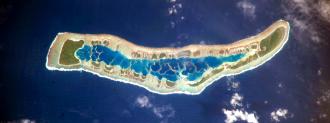Sea level rise threatens low-lying islands in the central Pacific Ocean, which may ultimately make current residents into climate refugees. But researchers are bringing attention to the natural processes that challenge the perception of island loss. Recently, the new president of the Republic of Kiribati has announced that he intends to keep the islands habitable by raising their elevation.
Kiribati is composed of 33 reef islands and atolls — ring-shaped coral reefs, surrounding a lagoon where a volcano once stood. Researchers estimate that by the end of this century, the world’s oceans will be .45 to .85 meters higher than they are today (and potentially even higher). Most of the Kiribati islands are only two meters above sea level. But even if the rising water doesn’t cover the island completely, it could bring additional risks like flooding and damaging storm surges.
Former Kiribati President Taneti Maamau sounded the alarm by anticipating that much of the island nation would be lost. He advocated that the residents should migrate “with dignity.” But the new president, President Taneti Maamau, is proposing a different plan to deal with sea level rise: elevate the islands through dredging and infrastructure changes. He said that Kiribati will look to China and other allies for support.
“The strategy is still in development but clearly identifies raising our islands as a way forward in our fight against climate change. This is also clearly demonstrated in our national climate change policy,” Maamau said, reports The Guardian.
Shifting Sands
In a 2018 study, Paul Kench, geomorphologist at Simon Fraser University in Canada, used satellite imagery to look at how the Pacific islands have changed over the last forty years. He found an overall increase in the land area of eight out of the nine atolls in Tuvalu, a Pacific island country.
Then, earlier this year, Kench and his team used mathematical models to demonstrate how waves toss loose sands onto the reefs, moving sediment from the beach inward to build up the island surface. Kench says this island growth can keep pace with rising sea levels.
But this doesn’t necessarily suggest that Kiribati is not in danger of rising seas.
The urgency is in getting on with the planning, securing the finance and the technological ability to pull this off.
Paul Kench
As the waves push sand to the island surface, the island gains height, but it also moves, shifting toward the center of the lagoon. Sea level rise and the moving landscape threaten homes and infrastructure, requiring an innovative plan to keep them safe.
Kench says it is doable.
“We’ve been urging the government to think about a comprehensive land-planning system, where they understand where all their land resources are and how they’re changing,” Kench told Fast Company. “The urgency is in getting on with the planning, securing the finance and the technological ability to pull this off. There’s time, but the window of time is shrinking.”
Kench is now working as an advisor to Maamau.
One solution Kench suggested is to replace the causeways between islands with elevated bridges. Causeways can cause beach erosion, but a bridge restores the water’s natural flow, possibly reducing flooding in the capital, Tarawa.
A Reason to Be Cautious
Gary Griggs, marine geologist at the University of California Santa Cruz, is “skeptical” that this plan will keep Kiribati habitable despite sea level rise.
“The fact that water levels are rising and the shoreline is moving, seems to provide clear evidence that accretion, if it is significant, isn’t happening fast enough,” he said in an email. “I don’t think this is going to counteract the effects of subsidence and sea-level rise.”
Griggs is dubious of all models. He says he likes “to see and measure things along real coasts.” Models aren’t perfect representations of the real world. Computer models are subject to the variables that the researchers include. And physical models can suffer from problems of scale.
Still, Kench argues that Kiribati is growing, so a solution is possible by raising houses on stilts, dredging, and dramatic infrastructure changes.
Mathematical models aside, the Kiribati nation has existed for centuries, even when faced with erosion and accretion and the relentless ocean swells. How they’ll continue to persist remains to be seen.
We’d love to hear from you! If you have a comment about this article or if you have a tip for a future Freethink story, please email us at [email protected]






